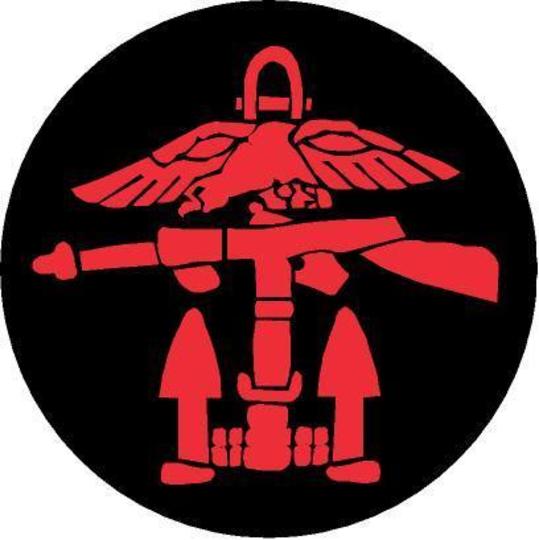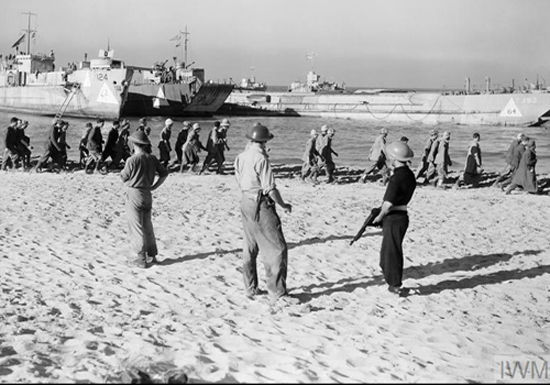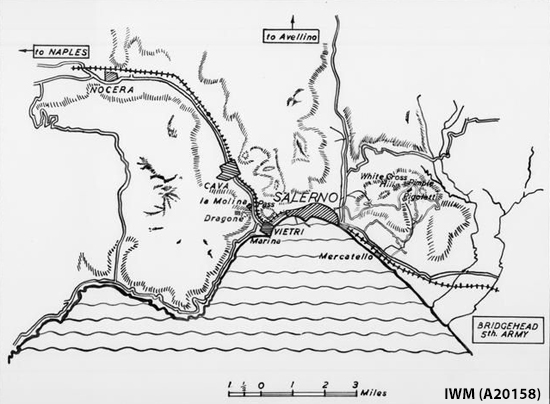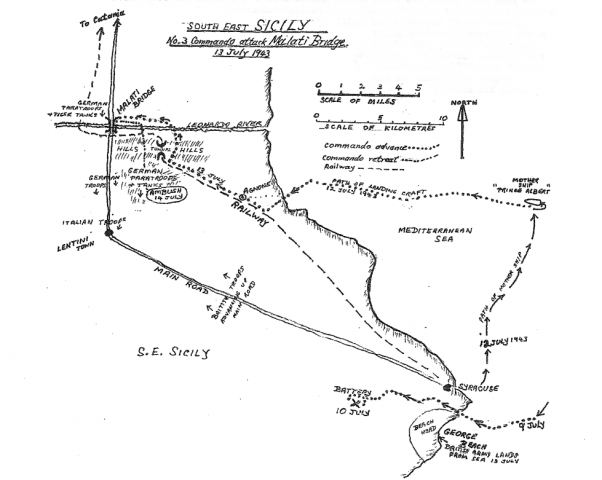Some Raids and Operations 1943
‘Norway - Operation Cartoon’
'Norway - Operation Crackers'
'Norway - Operation Carey'
Northforce section of No 12 Commando in operations in the Norwegian Fjords.
'Norway - Operation Checkmate'
 A combined operations raid on Axis shipping in the harbour at Kopervik, Norway. This raid was a No 14 Commando operation. The raiders managed to sink several ships using limpet mines, but were eventually captured and initially taken to Haugesund for interrogation before being transported to Sachsenhausen Concentration Camp.
A combined operations raid on Axis shipping in the harbour at Kopervik, Norway. This raid was a No 14 Commando operation. The raiders managed to sink several ships using limpet mines, but were eventually captured and initially taken to Haugesund for interrogation before being transported to Sachsenhausen Concentration Camp.
All but one of the group were executed whilst Prisoners of War. The man who was not died of Typhus in captivity before he could be.
The raid was led by Lt John Godwin, RNVR., who was in No 14 Commando as were the other Naval personnel. Sergeant Cox was attached to the group from No 12 Commando.
[Names below link to more about each man.]
All but Mayor and Roe were executed at Sachsenhausen Concentration Camp. These two men were transferred to the Concentration Camp at Belsen. Able Seaman Keith Mayor was executed there. Petty Officer Alfred John Roe died of Typhus. There is a Memorial at Sachsenhausen in memory of these men, and all the British and Commonwealth Forces, many still unknown, who were interned and perished there, or elsewhere, at the hands of their captors. These include the Commandos from Operation Musketoon [view].
‘Sicily - Operation Husky’

The invasion of Sicily. In addition to Commando units the Special Raiding Squadron (SRS) also participated. Whilst the SRS were engaged at Bagnara and Augusta and other areas, No 3 Commando's time in Sicily included one particular action at Agnone.
On the 14th/15th July 1943 No.3 Commando were tasked with taking and holding a bridge at Malati until the arrival of the 50th Division. After capturing the bridge from the Italians and removing the demolitions they had laid, a counter attack by the Germans with support of tanks inflicted heavy casualties on No.3 Commando.
Eventually they were ordered to withdraw, but the bridge had been saved from demolition.General Montgomery later ordered that a stone be carved with “3 Commando Bridge” and this stone cemented into the Malati bridge. An excellent account of the action can be found here :
Recollections of Sicily and Malati Bridge by Lieut. John Channon Erskine RE & No.3 Commando
One of the pillboxes still remains at the bridge and it can be viewed HERE.
The graves of some of the fallen from No 3 Cdo during this operation can be viewed on this link to our gallery for Syracuse War Cemetery
On the 22nd July 1943 No 2 Commando were sent to the action in Sicily. Read more about their part here in our No 2 Commando History section.
'Assault and Holding of Punta dei Malati'
Sam Hooper and Bill Everett
In 1942, an elite group of 120 former policemen joined one of the British Army's most notorious commando units.
In the early hours of 13th July 1943, Sam Hooper and his friend Bill Everett - both former policemen from Cardiff - stood on the deck of a British warship, surging towards the Bay of Agnone in Sicily.
"It was a very fast boat and it dropped us off about a mile from the beach," he recalled, "We had six landing craft on the boat and we went in formation to the beach in darkness. When we landed we had some terrible opposition from the Germans, but we got away with it."
It is a simple statement, but in fact the day was later recalled by one war historian as the 'most perilous enterprise' of the elite No.3 Commando unit's career.
It was Mr Hooper's third day of active service with the unit after a year of intensive training - and it was to be his last of the war.
He was one of a dozen policemen from Cardiff, who joined the unit in 1942, shortly after restrictions preventing police from volunteering with the armed forces were lifted.
Sam recalled how he and Mr Everett, who has since passed away, were put through rigorous training at the Commando Depot at Achnacarry in Scotland - where five-mile runs were a daily chore and being shot at with live ammunition was par-for-the-course.
"When I was home my mother would say things like, "Has that vest been aired?" he said.
"At Achnacarry it was wet socks and boots every morning and we would finish the day by walking through a river."
In January 1943, the former policeman and the rest of No.3 Commando boarded a boat for Gibraltar.
"I'll always remember that journey because it was absolutely horrific," he said.
"The biggest boat I had been in was a rowing boat in Roath Park, and here I was with waves 30ft high - it frightened the life out of me."
After spending some time in Gibraltar, the unit sailed to Suez in Egypt, where they began preparations for the allied invasion of Sicily. On 10th July 1943, Mr Hooper became one of the first Allied troops to set foot on Italian soil when he helped take down an enemy gun unit ahead of the invasion.
Just three days later his unit was sailing again under cover of darkness towards the Bay of Agnone, tasked to move up the beach behind enemy lines and take a bridge that had been rigged with German explosives. "The bridge was five miles inland and there were 350 of us," he said.
"We had a new type of weapon called a PIAT mortar, which went right through a tank and hit an ammunition wagon.
There was an enormous explosion and we all ran off, just as a Tiger tank came over the bridge and bombarded the devil out of us.
We had to split up and the group of chaps I was in ran straight into a German parachute division."
Mr Hooper and Mr Everett were both captured and taken by boat to Italy. Halfway through the journey, their ship was attacked by Allied aircraft.
"I was lying face-down and making myself the thinnest man in the British army to avoid being shot," he said.
Once on the mainland, the prisoners were handed over to the Italian army and taken to a 'flea-ridden' PoW camp near Naples, before being moved on to Austria.
There the camps were smaller and, although he and Mr Everett were separated, life was a little easier. But it did not stop Mr Hooper getting himself into trouble.
"When they asked us what we did I said I was a farmer," he said. "I was sent out to a farm and the woman in charge asked me if I could milk a cow. Of course I said yes - how hard could it be?"
"So she went and got a cow, put a stool and a bucket next to it and said, "Get started". I thought it was going to be easy, but I couldn't get a drop of milk. She realised pretty quickly that I wasn't a farmer."
Another time, he attempted a daring one-man escape on foot to Hungary, but was caught by German patrols on high alert after a mass break-out at a larger POW camp nearby.
"I was marched up before a military court and put in prison for several days," he said. "It was the first and only time I had a criminal record."
Finally, in May 1945, Mr Hooper was liberated and taken to France, from where he got a lift home to Britain in a Lancaster bomber.
"When I got home to Cardiff I didn't bother with the bus, just walked home to Whitchurch," he said. "When I saw my family it was an incredible feeling, unbelievable."
After a 'short break', he was back on the beat as a policeman in the city's Canton area, before joining the traffic department, where he and Mr Everett both remained until their retirement in 1971, after 30 years of service.
'Scaletta - Operation Blackcock (1)'
Operation Blackcock was a British amphibious landing to take Scaletta on the north-east coast of Sicily. Planned by Lieutenant General Sir Miles Dempsey’s XIII Corps, of General Sir Bernard Montgomery’s 8th Army, the operation was designed as one of a pair of Allied operations to cut off the last elements of the German forces trying to fall back to their evacuation point at Messina in north-eastern Sicily.
No 2 Commando History contains some more information [view]. [Source: National Archives records file DEFE 2/105, Combined Operations Headquarters: "Blackcock" and "Bullfrog" Date: 1943.]Notes This should not be confused with a later Operation Blackcock, an operation to clear German troops from the Roer Triangle, formed by the towns of Roermond and Sittard in the Netherlands and Heinsberg in Germany. It was carried out by the British Second Army in January 1945. The objective was to drive the German 15th Army back across the rivers Roer and Wurm and advance further into Germany. The operation was carried out by Lt-General Neil Ritchie's XII Corps by three divisions: the 7th Armoured Division (Major-General Lewis Lyne), the 43rd (Wessex) Infantry Division (Major-General Gwilym Thomas) and the 52nd (Lowland) Infantry Division (Major-General Edmund Hakewill-Smith). The National Archives hold the following records regarding this latter operation. DEFE 2/95 Combined Operations Headquarters: "Baboon" "Copyright" "Blackcock" "Bruteforce" "Barbaric" and "Bristle" Date: 1941-1945 WO 205/846 21st Army Group Operational reports: Operation Blackcock Date: 1945 Jan WO 205/847 Operation Blackcock: working papers Date: 1945 Jan. WO 205/848 Operation Blackcock: 7 Army Division Date: 1945 Jan. WO 205/849 Operation Blackcock: 52 Division Date: 1945 Jan WO 351/60 21 Army Group: Operation "BLACKCOCK"; clearing the area between the River Maas and the River Roer 15-26 January 1945 Note: With maps Date: 1945 Jan 01 - 1945 Dec 31
Vibo Valentia - Operation Ferdy
40RM Commando and two troops of 3 Commando were engaged on this amphibious dawn landing at Vibo Valentia, known at the time as Porto San Venere, on the southern tip of Italy. The following day 'X' troop of 40RM Commando entered the neighbouring town of Pizzo (The Green Beret by Hilary St George Saunders).
Salerno - Operation Avalanche

The allied invasion of Italy
Read an account about No 2 Commando involvement in this operation - [View here.]
'Salerno Diary'
First published March 1944.
2 Commando War Diary 18/19th September 1943
No 2 Commando War Diary 18th September 1943, and part of the entry for the 19th.
[Transcribed from the 2 Cdo.War Diary]
"A daylight recce patrol went out under Command of Lieut. Keep. Dug in positions on the lower slopes of the hill were found with line connections to each other. They were equipped with beds and camp furniture. They were unoccupied and must have taken some weeks to construct. All the enemy dead seen in previous patrols had been removed, also most of our own, only badly mangled British dead being left. From the side of the hill it was possible to observe a stretch of the road invisible from Piegolelle*, and a group of buildings (700335) was observed to be the scene of much enemy activity. Tanks and staff cars kept coming and going, also D.R's. Fire was suddenly brought to bear on the patrol by the enemy, who, it was found, were in force still further up the hill. Mortar bombs began to fall round the patrol and some stick grenades were thrown. Fire was returned whilst the map reference was taken, then the patrol returned. Mortared on the way from the valley, three of the patrol were hit by fragments.Lt-Col. J.M.T.F. Churchill, MC, ordered the officer i/c Patrol down to Brigade to give direct information, it being hoped that the buildings were being used as Div. H.Q. by the enemy. He was taken to the G.I. of 48 Div. who arranged a Divisional Artillery Shoot on the target. It was later reported destroyed together with tanks sheltering in the vicinity. An attack was put in by one of the neighbouring Brigades on White Cross Hill and The Pimple under supporting fire of Artillery, and the Commando, but this achieved only a very limited success. The heavy concentration of 3" and 4.2" mortar fire ( American [1] ) which the Commando had never ceased to put down on the Pimple was having its effect, and by nightfall, no return fire had been experienced for several hours. During the night the Commando was drawn into reserve in the Mercatello area, and fresh troops went forward on the 19th September to find the Pimple evacuated and strewn with enemy dead. No 2 and 41 (RM) Commandos in 10 days had suffered severe casualties - 13 Officers had been killed , and 15 wounded. 54 O.R.'s were killed and 225 wounded, while 1 Officer (R.M.) and 59 O.R.'s were missing. [2] These figures amount to 48% of the strength of the two Commandos when they landed on the 9th September at Marina."
Commando Roll of Honour for Salerno 9th -20th September 1943 - [View Here.]
Notes [1] The 2 Cdo war diary entry for the 17th states that the Commando had been reinforced by seven 4.2" mortars of the US Mortar Bn. under the command of the Special Service Brigade [2] The final Roll of Honour on the link above records a total of 14 Officers and 71 O.R.’s from Nos.2 and 41RM who were killed in this period. * Often mis-spelt as Piegolette.
2 Commando Salerno/Scaletta Casualties

A document created by an officer of No 2 Commando with specifics of No.2 Commando casualties at Salerno, and locations of where they lay, or were first buried. It also includes details of three from the action at Scaletta, Sicily the previous month.
Termoli - Operation Devon
Amongst the Allied forces taking part were No 3 Army Commando, 40RM Commando, and the Special Raiding Squadron (SAS). They captured Termoli, thus unhinging the German defensive position along the river Bifurno. The enemy counter-attacked violently. For a time confusion reigned and the situation was critical, but the great steadiness of the Commando troops under Lt Col. Durnford-Slater, saved the town.
An account of No 3 Cdo 6 troop action written by Jack Cox who served in 6 troop can be read HERE
'French Coast - Operation Hardtack 11'
Italy - Operation Partridge
29th/30th Dec.'43. A diversionary raid behind enemy lines in the area of the Garigliano River, Italy. The intention was to cover the withdrawal of X Corps in preparation for its proposed assault across the Garigliano river.
